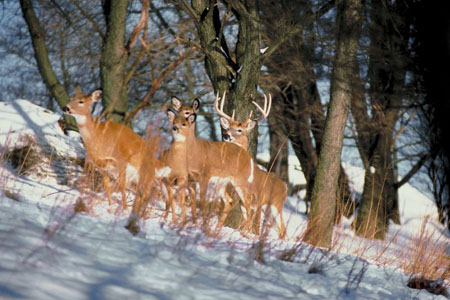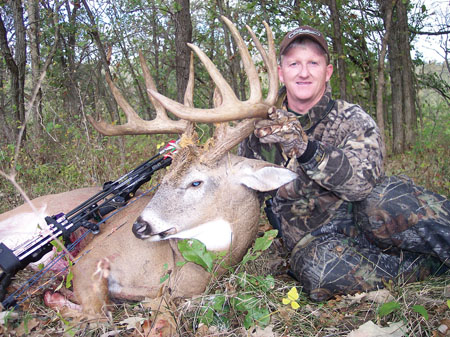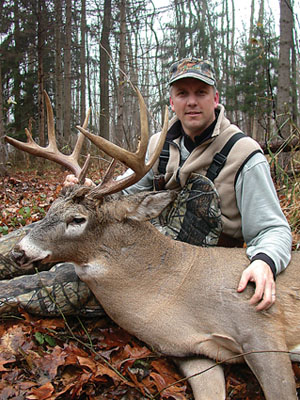Locate Concentrations of Deer
 Jeremiah Parker, marketing manager for Leaf River Outdoor Products, begins the late season by zeroing in on food sources such as late soybeans. "I am not as concerned with locating a big buck or two, but rather finding large concentrations of deer. The more deer there are feeding comfortably out in the open, the more likely a mature buck will appear during legal shooting hours. He will be seeking not only food, but maybe one more chance to breed.
Jeremiah Parker, marketing manager for Leaf River Outdoor Products, begins the late season by zeroing in on food sources such as late soybeans. "I am not as concerned with locating a big buck or two, but rather finding large concentrations of deer. The more deer there are feeding comfortably out in the open, the more likely a mature buck will appear during legal shooting hours. He will be seeking not only food, but maybe one more chance to breed.
"I then set up trail cameras all around the field in the hopes of photographing a racked deer. On one 3,000-acre lease I set out 25 to 30 trail cameras along the perimeter of 4- or 5-acre fields. You must do this as quickly and as scent-free as possible. I have the cameras pre-set, and don’t fiddle and fidget around when positioning the cameras. I also wear rubber boots and spray myself down with a quality scent elimination spray. We know when someone breaks into our house; so do mature bucks!
"In addition I often set out mock scrapes in front of the camera," says Parker, "and also legal scents and lures in order to increase my odds of a big buck sighting. Using cameras to help scout your hunting turf is important, especially for guys and gals who only have a weekend or two to bowhunt the late season. In these cases, ‘trophy’ is in the eyes of the beholder. But if I am looking for an exceptional deer, and I know from my trail cameras that a big buck is frequenting a certain feeding area, then I will not take the first buck that shows himself, but rather hold off a bit. Those big mature bucks seem to always wait for the last minute before arriving at a field filled with does."
Hunt Late-Season Food Plots
 Jay Gregory, pro staffer for Millennium Treestands and host of The Wild Outdoors television show, believes the late season actually starts in the summer. "Locating bucks in the late season can be a tough assignment. Food is the key, but natural food sources such as acorn flats, stands of pod-bearing locust, and wild apple orchards can spread deer around as can cut corn lots and harvested bean fields.
Jay Gregory, pro staffer for Millennium Treestands and host of The Wild Outdoors television show, believes the late season actually starts in the summer. "Locating bucks in the late season can be a tough assignment. Food is the key, but natural food sources such as acorn flats, stands of pod-bearing locust, and wild apple orchards can spread deer around as can cut corn lots and harvested bean fields.
"It is much better to plant your own food plots. I like to have standing corn and standing bean fields as well as green plots of winter oats and brassicas available during the late season. Then when the regular deer season ends and winter rolls in, bucks will come to the food plots to replenish their fat supplies and maybe have one last sexual encounter. I hope for severe weather now as the deer will yard up around the food source. It is like hunting them in a smaller pond. It is a lot easier to know where they are going to be spending the majority of their time.
"We will use rattling horns and try calling to bucks that seem to be walking away from us, but we do so sparingly. Late season bucks are generally thinking more about food than sex, so we hunt them on a feeding pattern.
"Bowhunting the late season over a food plot is not without its risks," adds Gregory. "There are generally a lot of deer in the immediate area, and they are still skittish from the gun season. You must exercise extreme caution erecting your treestand, and that stand must be both comfortable and quiet. Any fidgeting or metal-on-metal noise once you climb on board will also spook nearby deer. Keep in mind that the higher you climb, the more likely you are to be skylighted due to the lack of foliage."
Create Mock Scrapes
 "I am a believer of using scents to stir up deer in the late season," says Kevin Kishel, president of Kishel’s Scents and Lures. "Bucks don’t stop being territorial, and over the years I have used mock scrapes to bring high-pressured bucks in for kill shots. Bucks, by the way, that have gone nocturnal or are holed up on posted property that I do not have access to.
"I am a believer of using scents to stir up deer in the late season," says Kevin Kishel, president of Kishel’s Scents and Lures. "Bucks don’t stop being territorial, and over the years I have used mock scrapes to bring high-pressured bucks in for kill shots. Bucks, by the way, that have gone nocturnal or are holed up on posted property that I do not have access to.
"Typically I set out my mock scrapes near bedding areas and attend to them once a week to keep them fresh. Even when most bowhunters think the rut is over, racked bucks are still looking for hot does. I scrape the ground clean, and add interdigital and tarsal gland scents to the mock scrape and douse the licking branch with preorbital gland lure. Then I add some buck urine to the mix. I believe this calms them down and helps them feel a little bit safer knowing another buck is around. It is like adding frosting to a cake.
"You must be patient when bowhunting over a mock scrape,” adds Kishel. "Mature bucks have learned to adapt to hunting pressure. They will let a younger buck approach the mock scrape, using him like a guinea pig, before showing themselves. If you can hold off from shooting a yearling animal, your chances for a big buck will skyrocket.
"You must also be as stealthy as possible during the late season. In some cases bucks have been hunted hard for better than three months and are on high alert. This means you must pay close attention to the wind, practice scent control, and eliminate other errors, such as avoiding erecting squeaky treestands near known buck bedding areas, to be successful."






